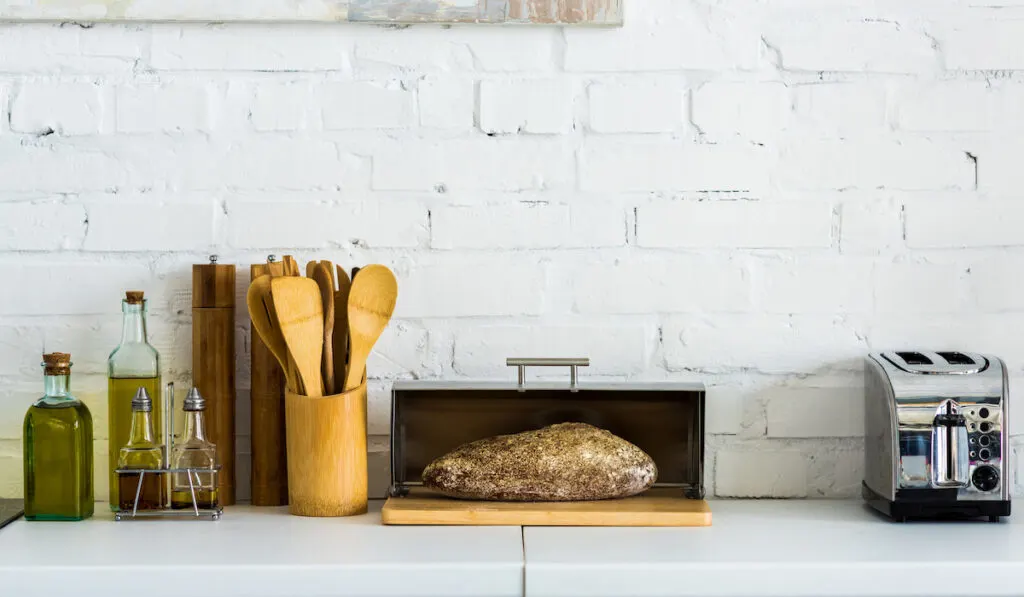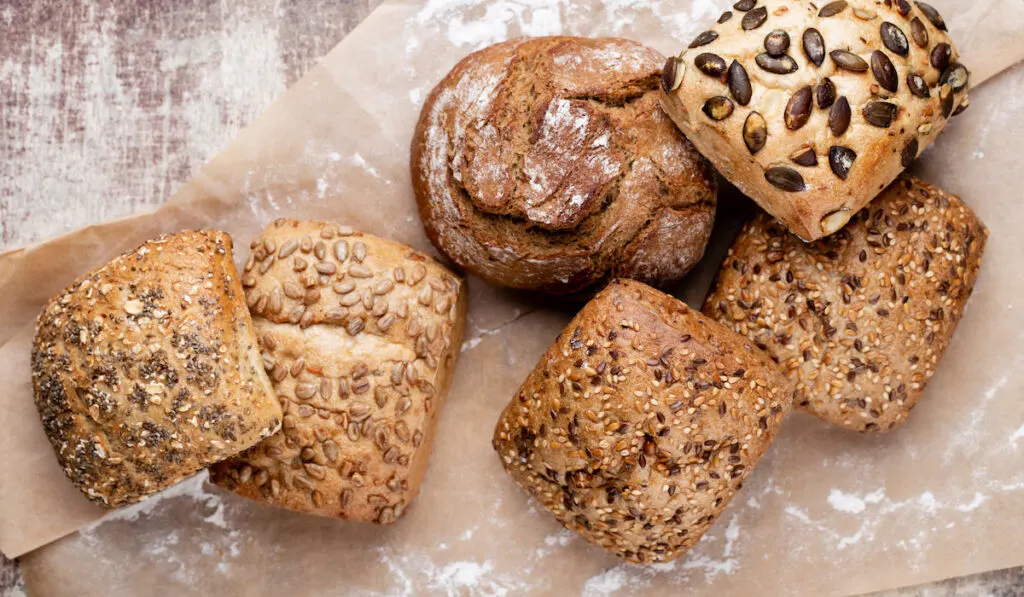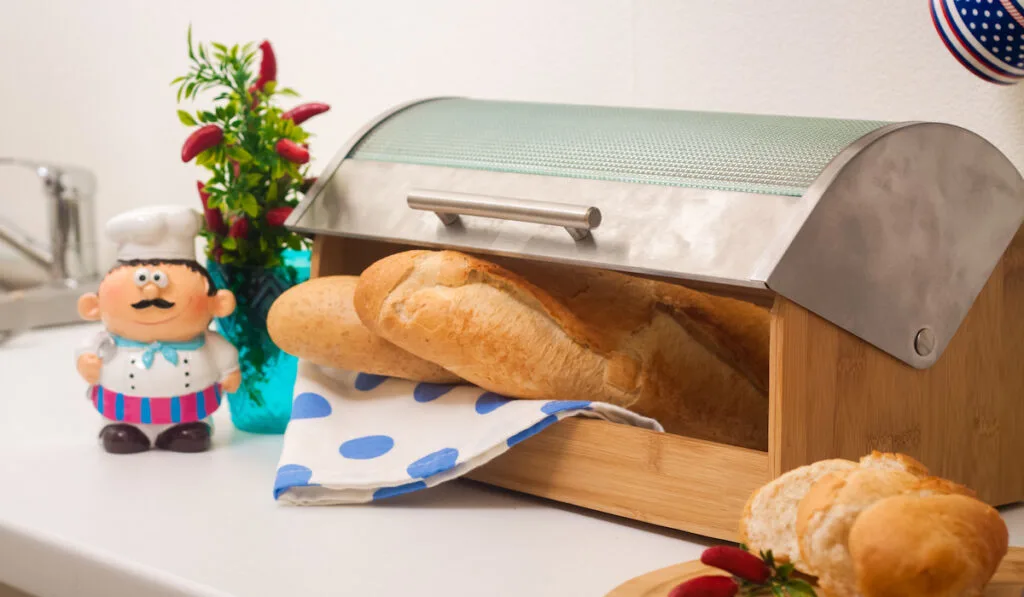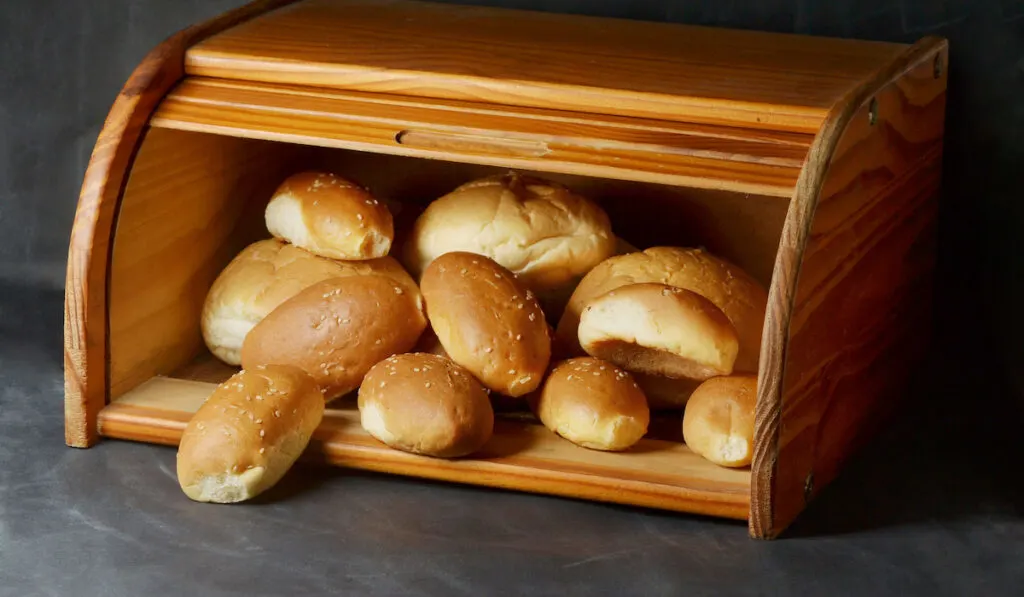Do bread boxes keep the bread from molding? — is a common question that people ask these days.
Bread boxes are returning to our kitchens because they’re the best way to preserve bread and stop it from going moldy and stale.
They became redundant with the rise of store-bought, packaged bread, which contains preservatives and stays fresh for several days on the countertop.
However, most people prefer the taste of freshly baked bread compared to a store-bought loaf.
The problem is fresh bread won’t keep as long on the counter.
Below, we’ll discover why bread boxes are the best way to store bread and other storage tips.

Table of Contents
The Benefits of Bread Boxes
Aside from keeping bread soft and fresh for several days, bread boxes look nice on the countertop and keep bread safe from damage.
Bread boxes are incredibly versatile and have many benefits:
- They look nice — Bread boxes come in many modern and vintage designs and are a fantastic way to add color and character to your kitchen.
- A bread box keeps the kitchen tidy — Plastic and paper bags look messy on the countertop and often spill out crumbs.
- You can store many items in a bread box — You can use it to keep many items fresh, such as muffins, bagels, cupcakes, and other baked goods.
- They’re cost-effective — A bread box will save you money because it reduces the amount of wasted bread.
- They protect bread — A bread box will prevent the bread from being squashed and keep most pests and bugs out.
- Bread boxes are environmentally friendly — They reduce the amount of plastic and paper waste in the home.

How Do Bread Boxes Keep Bread Fresh?
Bread boxes keep bread fresh because they regulate the air, light, and moisture reaching the bread.
Air and moisture are the main things that cause bread to spoil. If bread is exposed to too much air, it will crystallize the starch, making it hard and stale.
However, bread boxes aren’t airtight — they allow air to circulate. If the bread can’t breathe, it will retain moisture, creating the perfect environment for mold.
A bread box traps just enough moisture to keep the bread soft in the middle and crispy on the outside and prevent mold.
With the correct amount of air and circulation, mold won’t form, and bread won’t become hard and stale— well, at least for a few days.
A bread box also provides a stable temperature for bread, which is crucial because if bread is hot, it will dry out — if it’s cold and moist, it will go soggy.
Bread boxes also block out light. While mold prefers a moist environment, it also depends on light, which is low in a bread box.
Exposure to light can dry the bread out and make it stale faster.
Bread boxes don’t preserve bread forever, but they can certainly extend the shelf life by several days, depending on the type of bread.

How Long Does Bread Last in a Bread Box?
A bread box will extend the life of bread by 2 to 4 days, depending on the bread.
Fresh white bread goes stale quickly on the countertop, sometimes within 24 hours, but will stay fresh for around 3 days in a bread box.
Wholemeal and sourdough bread has a longer shelf life. Dark loaves will last around 4 to 5 days in a box, compared to 2 to 3 days on the counter.
Store-bought bread usually has preservatives and has the longest shelf life, 4 to 5 days, which you can extend if you keep it in a bread box.

Tips for Keeping Bread Fresh
The best way to keep bread fresh is in a bread box. Keeping bread in a plastic bag or airtight container will cause it to hold moisture and become a breeding ground for mold.
Fresh bread on the refrigerator or countertop will quickly become stale.
To get the best results from your bread box, remove the packaging before you put the bread in.
Avoid pre-sliced bread, which spoils faster. Slice the loaf from the middle and put the two halves back together to create a seal.
Always keep bread in a cool, dark, dry area – ideally, store one loaf at a time in your bread box.
You can’t eat moldy bread because it might make you ill, but here’s a list of things you can do with stale bread:
- Toast it — You won’t notice it’s stale when it’s toasted.
- Revive it in the oven — You can put bread in the oven at 350°F for 15 minutes to revive it. Soak it in water first if it’s really hard.
- Make breadcrumbs — Use a food processor or blender to turn stale bread into crumbs.
- Create croutons — Cut stale bread into squares and bake it in the oven, with a dash of oil and seasoning to make delicious croutons.
- Bake bread and butter pudding — This is a simple, classic dessert you can make with stale bread.
How to Choose a Bread Box
You must consider the style, design, and material to choose the best bread box for your needs.
We’ll take a closer look at these factors below:

The Material
The bread box material is a crucial thing to consider. You must choose the correct one for your environment.
Coated metal and stainless-steel boxes are the most durable but can scratch soft kitchen countertops. They also conduct heat, sothey aren’t suitable for areas with fluctuating or extreme temperatures.
Modern bread boxes come in BPA-free plastic mixed with sustainable materials such as bamboo.
Wooden bread boxes are breathable, so they are fantastic for circulation and moisture regulation, but sometimes the wooden smell can transfer to the bread.
The Style and Design
There are many bread box styles and designs. Some are modern and sleek — others have a classic, vintage look. Some have roll tops, while others have a lid.
Some boxes even have lids that double as cutting boards.
The bread box design usually won’t affect how long your bread stays fresh, so choose one that compliments your kitchen.
The Size
Choosing the correct-sized bread box is crucial. If it’s too small, there will be too much moisture and not enough air circulation, which will cause mold.
If your family consumes a lot of bread, choose a large box – if you don’t, choose a regular size.

Summary
A bread box is one of the best ways to store bread and will prevent it from going stale and molding and will extend the shelf life by several days.
Wood, stainless steel, coated metal, and BPA-free plastic are the best bread box materials.
To get the best results from a bread box, choose an appropriate size for your needs, keep it in a cool, dry area and don’t overfill it with bread.
If you put too much bread in a box, it will retain moisture which can make bread go moldy.
Resources
- https://thebreadguide.com/how-to-store-bread/
- https://momsbakingco.com/why-use-a-bread-box/
- https://www.bakingkneads.com/how-to-keep-bread-from-molding/
- https://oureverydaylife.com/light-affect-long-bread-keep-28649.html
- https://www.bbcgoodfood.com/review/best-bread-bins
- https://www.thespruceeats.com/best-bread-boxes-5183918
- https://www.tasteofhome.com/article/how-to-keep-bread-fresh/
- https://www.rd.com/article/how-to-keep-bread-fresh-breadbox/
- https://cooking.stackexchange.com/questions/23346/what-makes-bread-mold-grow-light-air-or-both
- https://cooking.stackexchange.com/questions/5071/whats-the-purpose-of-a-bread-box
